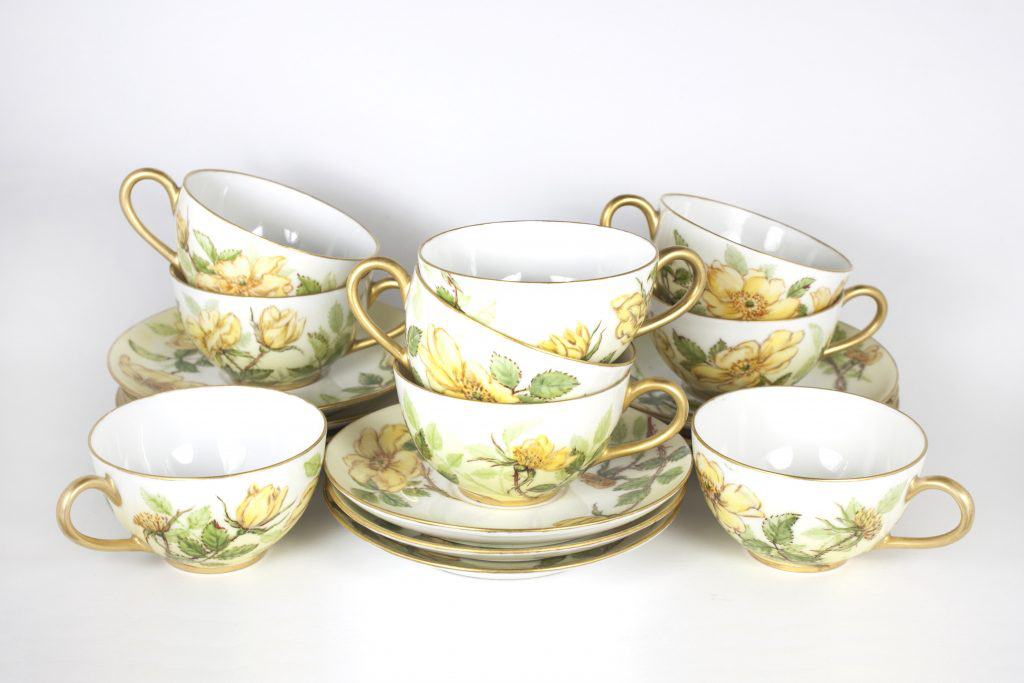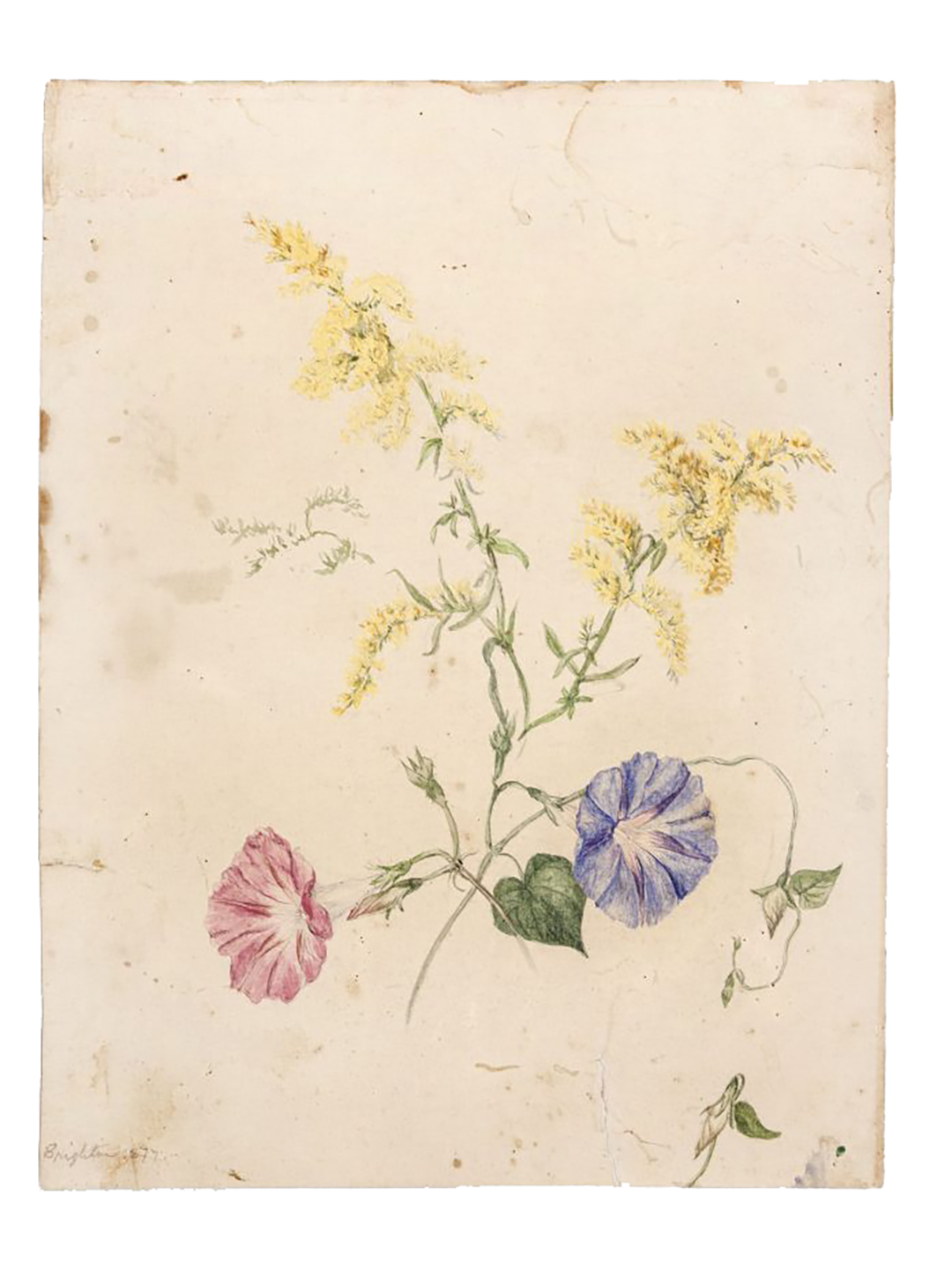home_news
In Conversation with Cole Fellow Amanda Malmstrom

Emily Cole, Cups and saucers, c. 1900, painted Limoges porcelain, various sizes. Courtesy of Thomas Cole National Historic Site, Catskill, NY, Gift of Edith Cole Silberstein.
History and Art History alum Amanda Malmstrom (BA, 2018) curated The Art of Emily Cole in her role as a 2019 Cole Fellow at the Thomas Cole National Historic Site in Catskill, NY. Her work was undertaken in conversation with Thomas Cole Site Curator and Director of Collections, Kate Menconeri, and research conducted by Rowanne Dean, 2017-18 Cole Fellow. It is the first solo exhibition of Emily Cole’s artwork on both paper and porcelain, revealing her exquisitely painted botanicals. Emily Cole (1843-1913) was the daughter of renowned artist Thomas Cole (1801-1848) who founded America’s first major art movement, now known as the Hudson River School. Amanda also developed a new guided tour to accompany the exhibition entitled The Women of Cedar Grove at the Thomas Cole National Historic Site.
We recently caught up with Amanda to talk about her time as a Cole Fellow and her experience curating The Art of Emily Cole.
Fine Arts Program: Congratulations on your fellowship at the Thomas Cole National Historic Site and on the opening of The Art of Emily Cole. Tell us about your experience at Thomas Cole and curating the first solo exhibition of Emily Cole’s work at an organization with such unique significance in the history of American painting.
Amanda Malmstrom: I am currently living in the beautiful Hudson River Valley of upstate New York and working as a Cole Fellow at the Thomas Cole National Historic Site. Now an exhibiting museum, the Cole Site marks the historic home of painter Thomas Cole (1801-1848) and the birthplace of the first major American art movement - referred to as the Hudson River School. As a Cole Fellow, I get to have my hands in many aspects of the museum’s operations - including leading tours, working on exhibitions, and engaging with interpretive programming. A major aspect of my work also includes conducting research -- I am specifically exploring the women who painted in the Hudson River School as well as the women who lived at the home of Thomas Cole, historically referred to as Cedar Grove.
My research on Emily Cole (1843-1913) -- botanical artist, lifelong resident of Cedar Grove, and daughter of Thomas Cole -- evolved into curating an exhibition of her watercolors on paper and painted porcelain. Rather than picking sweeping and sometimes sublime vistas of landscapes, Emily chose as her subject plants and flowers, close-up and in isolation. Many of the plant and flower species on view—goldenrod, peonies, thistle, and strawberries—grow locally in the Hudson Valley and were probably those she encountered in her own gardens here at her home and in the surrounding landscape. Displayed in the room that Emily grew up in as a child, these objects are accompanied by wall text highlighting Emily’s biography, the history of botanical art, and the nature of porcelain painting. As someone passionate about women’s history and gender studies, curating this exhibition was an exciting and rewarding endeavor. While the life and work of Thomas Cole is the focus of our site, I believe it is also important to showcase the lesser-known labors of women. I hope that The Art of Emily Cole, the first known solo exhibition of Emily Cole’s work, encourages visitors to see nineteenth-century American art in a broader sense, a picture that includes the work of women.

[Emily Cole, Untitled, n.d., watercolor and pencil on paper, 7 5/16″ x 10 5/16″. Courtesy of Thomas Cole National Historic Site, Catskill, NY, Gift of Edith Cole Silberstein.]
FA: The exhibition features 15 original sets of painted porcelain (c.1900-1910) and 18 works on paper (c.1870-1880). What are some interesting challenges or special considerations when working with and handling objects like these in the context of an exhibition?
AA: The Cole Site is a historic 19th-century house, not a white box gallery space. Therefore, many challenging curatorial decisions went into the organization of The Art of Emily Cole. Only a small selection of Emily Cole’s extensive corpus of works, including over one hundred watercolors on paper and painted porcelain objects, could be exhibited in the historic room designated as the exhibition space. After narrowing down the works I wished to be included in the exhibition, I had to make special lighting considerations for the delicate nature of the works on paper. Additionally, since the porcelain works of Emily Cole served both functional and decorative purposes, I wanted to exhibit them in a way that would pay homage to both. Some plates are hung on the walls, but others rest on pieces of historically-accurate furniture. Thus, The Art of Emily Cole retains historical accuracy in the light of contemporary curatorial practice.
.jpg)
[Photo courtesy of Amanda Malmstrom]
FA: You also developed a 45-minute tour entitled The Women of Cedar Grove that accompanies the exhibition. Tell us about your experience developing this public educational program.
AA: Guided tours are the main way that visitors experience the Thomas Cole National Historic Site. Yet, the historic property was never owned by the artist himself, but by the family of his wife, Maria Bartow Cole. It was then passed on through a succession of Cole family women. Throughout the nineteenth and twentieth centuries, women served important roles as titleholders, artists, and stewards of the property. I believed it important to highlight the lives and work of these women, without whom the site would not be the education organization that it is today. Thus, I wrote “The Women of Cedar Grove” tour script and trained our staff to facilitate this special tour during our weekend hours in March -- Women’s History Month. It has been a great experience to see visitors’ positive responses to “The Women of Cedar Grove” tour!
FA: As a junior at LUC you were awarded a Myser Research Grant in support of a research project that examined the artwork of Ade Bethune and Rita Corbin in The Catholic Worker Newspaper. How did your History and Art History training at Loyola, and your interest in the art practices of women prepare you for the Cole Fellowshp?
AA: I came to the Cole Site from Loyola, having recently written theses on the art of the Catholic Worker newspaper as well as the contemporary feminist art of the SisterSerpents. The artwork involved in both of these research projects was radical in nature, holding explicit social justice agendas. What a jump it has been from studying the activist imagery of newspapers and ephemeral posters to being immersed in the rooted history of American painting! Yet, because social justice and women’s studies was at the core of my History and Art History education at Loyola, I have continued to seek out projects that I find meaningful at the Cole Site. This has included both The Art of Emily Cole exhibition and “The Women of Cedar Grove” tour - which both aim to insert the stories and work of women into the male-dominated canon of American art.
FA: What advice would you give to current Art History majors at Loyola?
AA: I would encourage Art History majors at Loyola to allow interests inside and outside of the classroom to inform your research and studies -- work imbued with your own passions always ends up becoming your best work. I also believe it is important that we, as young art historians, continue to break through the rigid canon of art history -- fight for stifled voices to be heard and allow for art to combat injustice!
FA: What are you plans after completing your fellowship at Thomas Cole?
AA: I love working in art museum settings, and I am planning to continue doing so when my fellowship ends.
The Art of Emily Cole is on view at the Thomas Cole Historic Site in Catskill, NY through July 7, 2019. The Women of Cedar Grove exhibition tour is offered every weekend in March at 11am and 1pm. The exhibition is supported by the New York State Council on the Arts with the support of Governor Andrew M. Cuomo and the New York State Legislature.


